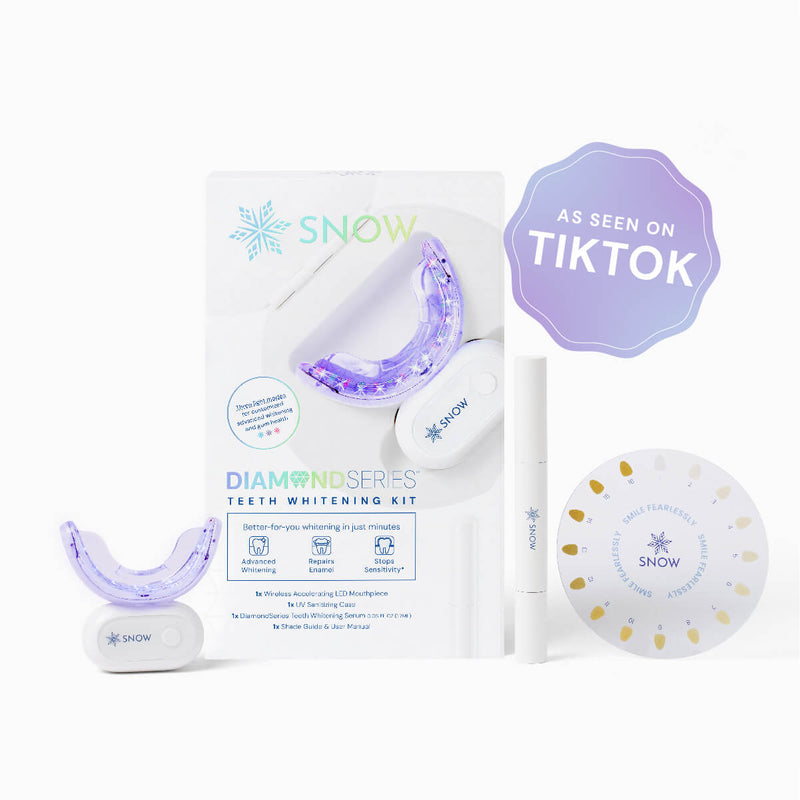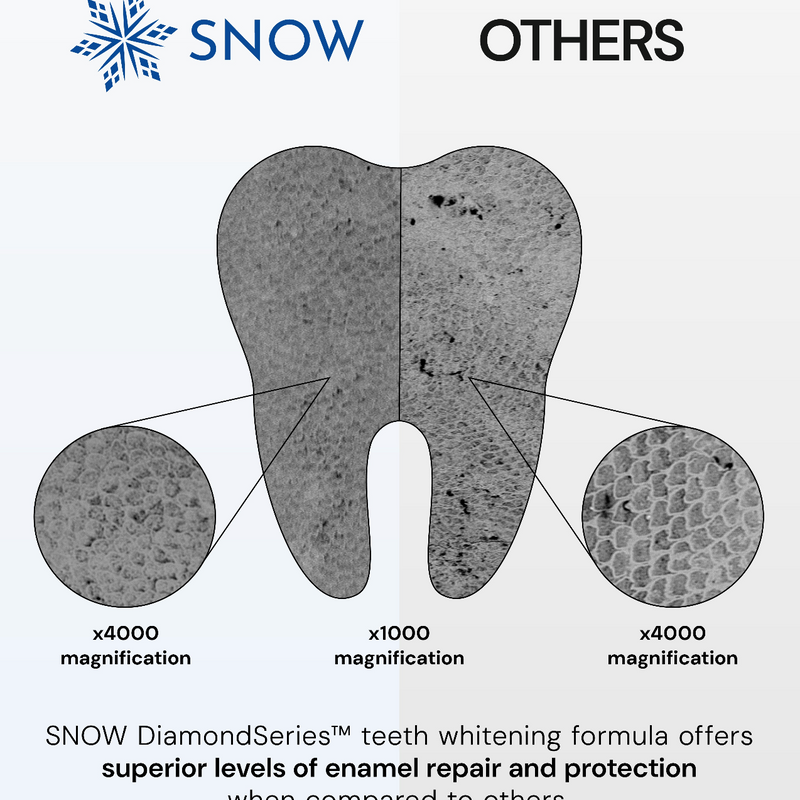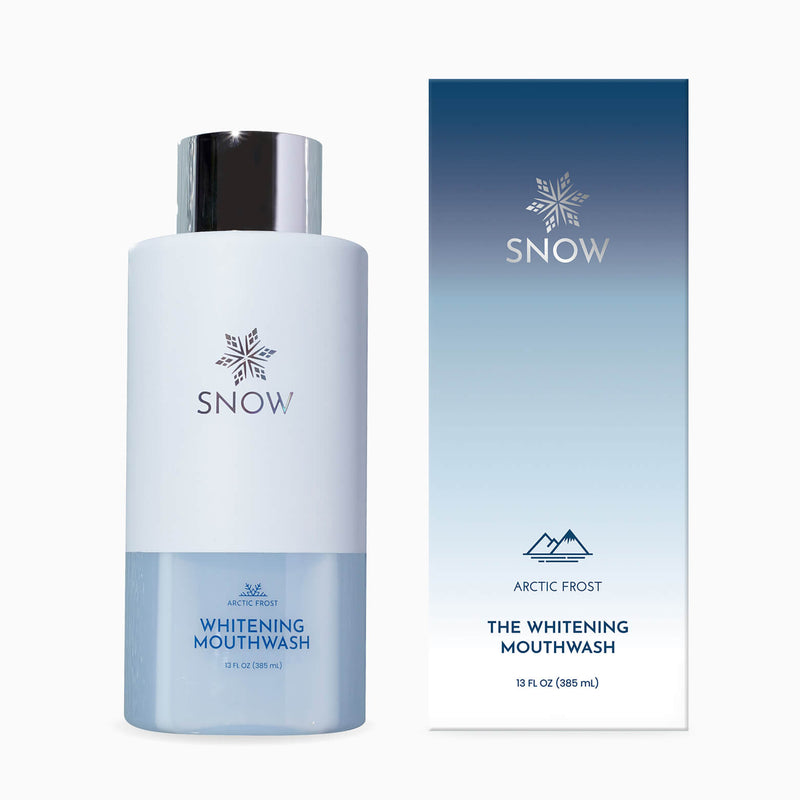What does fluoride do in toothpaste? Fluoride strengthens tooth enamel and helps prevent cavities by making teeth more resistant to decay.
This article will delve into precisely what fluoride does, the different types of fluoride used in toothpaste, and the potential side effects of fluoride use.
We'll also guide you on how to choose the best toothpaste and explore fluoride alternatives, like nano-hydroxyapatite, xylitol, and coconut oil.
Without further delay, let's begin!
What this article covers:- What Does Fluoride Do?
- What Are the Different Types of Fluoride in Toothpastes?
- What Are the Side Effects of Fluoride?
- Choosing the Best Toothpaste
- Fluoride Alternatives
What Does Fluoride Do?
Based on our observations, fluoride undergoes a chemical process with tooth enamel that impacts the structure of the enamel.
Despite its widespread use, there are ongoing discussions about the necessity and safety of fluoride in dental care.
At SNOW, we offer products that cater to different preferences, including those who prefer fluoride-free options for their oral hygiene routines.
If you're looking for an effective alternative that promotes a bright smile, consider the SNOW teeth whitening kit. This kit features LED-activated whitening technology designed for sensitive teeth.
Recommended for daily use over 21 days, this kit includes three whitening wands and a mouthpiece with an LED light for a quick effect.
What Are the Different Types of Fluoride in Toothpastes?
Our findings show that fluoride is available in various forms in toothpaste, each offering distinct properties. The most common types include sodium fluoride, stannous fluoride, and sodium monofluorophosphate.
Sodium fluoride is often used for its stability and effectiveness in preventing tooth decay. Stannous fluoride, on the other hand, offers additional benefits like antibacterial properties, which help reduce plaque and gingivitis.
Sodium monofluorophosphate is another form of fluoride commonly found in toothpaste, known for its gentle action on enamel while still providing protective benefits.
For those who prefer a fluoride-free option, SNOW's teeth whitening foam is an excellent choice.

Does whitening toothpaste work? It does. Many customers report noticeable improvements.
What Are the Side Effects of Fluoride?
While fluoride is widely used in dental care, it can have side effects if consumed in excessive amounts.
Based on our observations, one of the most common issues is dental fluorosis, which occurs when children ingest too much fluoride during the development of their teeth, leading to discoloration and mottling of the enamel.
Fluoride toxicity is another concern, primarily if large quantities are ingested. Symptoms can include nausea, vomiting, and abdominal pain. In rare cases, excessive fluoride intake can lead to skeletal fluorosis, affecting bones and joints.
It is crucial to use fluoride toothpaste as directed and keep it out of reach of young children to prevent accidental ingestion.
If you're concerned about fluoride intake but still want effective whitening, the Arctic Frost teeth whitening mouthwash by SNOW is a great alternative. It is alcohol-free, soothes gums, and is enriched with botanical extracts like aloe and peppermint oil.
Choosing the Best Toothpaste
Selecting the right toothpaste involves considering factors like fluoride content, whitening properties, and sensitivity needs.
For those who prefer fluoride-free options, SNOW's Nano-Hydroxyapatite teeth whitening toothpaste is an excellent choice.
This toothpaste uses nano-hydroxyapatite to strengthen enamel and whiten teeth naturally, catering to individuals with sensitive teeth.
Ingredients like peppermint oil, xylitol, and coconut oil are included to provide a refreshing taste and additional health benefits.
How does sensitive toothpaste work? Sensitive toothpastes typically contain ingredients that block the transmission of pain signals from the tooth surface to the nerve endings inside the tooth, providing relief from sensitivity.
Another option for those seeking fluoride-free oral care is SNOW's teeth whitening powder. This powder uses natural ingredients like activated charcoal to remove stains and whiten teeth effectively.

How long does it take for whitening toothpaste to work? Results vary, but users report seeing improvements in tooth color after 2-4 weeks of consistent use.
Fluoride Alternatives
For those seeking alternatives to fluoride in their dental care routine, there are several effective options available. Here are 3 we believe work best.
Nano-Hydroxyapatite
Nano-hydroxyapatite (n-HA) is a naturally occurring mineral that has gained popularity as a fluoride alternative.
It works by mimicking the structure of natural tooth enamel, which helps to repair and strengthen teeth. n-HA has been shown to be effective in reducing tooth sensitivity and protecting against cavities.
Xylitol
Xylitol is a sugar alcohol that is widely recognized for its dental benefits. It helps to reduce the risk of tooth decay by inhibiting the growth of cavity-causing bacteria.
Xylitol can be found in various dental products, including toothpaste, mouthwash, and chewing gum. At SNOW, we incorporate xylitol in our fluoride-free formulations to support our customers' diverse needs.
Coconut Oil
Coconut oil is another popular fluoride alternative known for its antimicrobial properties. It is commonly used in a practice called oil pulling, where the oil is swished around in the mouth to reduce bacteria and improve oral hygiene.
Does toothpaste kill bacteria? Many toothpastes contain antibacterial ingredients that can help reduce harmful bacteria in the mouth, contributing to overall oral health.
For a convenient, on-the-go whitening solution, SNOW's Magic teeth whitening strips are your number one choice.
Conclusion
Fluoride in toothpaste plays a role in improving enamel strength and preventing cavities, making it a staple in oral health products.
We've explored the various functions of fluoride, the types found in toothpaste, and potential side effects associated with its use. We also discussed how to select the best toothpaste for your needs and reviewed several effective fluoride alternatives, like nano-hydroxyapatite, xylitol, and coconut oil.
Elevate your oral care routine with SNOW's high-quality dental products, designed to meet diverse needs and preferences.
If you want to learn more, why not check out these articles below:
- Does Purple Toothpaste Work
- How Long Does a Tube of Toothpaste Last
- Best Toothpaste for Sensitive Teeth
- Best Purple Toothpaste
- Best Hydroxyapatite Toothpaste
- Best Toothpaste Tablets
- Best Toothpaste to Prevent Cavities
- Best Toothpaste for Coffee Stains
- Can You Bring Electric Toothbrush on Plane?
- Travel Electric Toothbrush
- Brushing Lips with Toothbrush
- What Is the Back of the Toothbrush for?
- Should You Wet Your Toothbrush
- Electric Toothbrush Stops Spinning When Brushing Too Hard
- How Should You Hold the Toothbrush During Brushing?
























